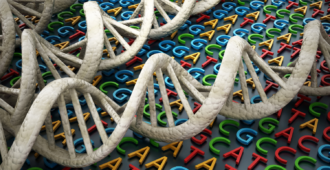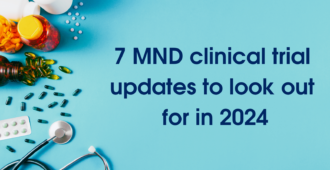For the purposes of this blog, ALS should be taken to mean ALS/MND.
In September 2020 we published a blog article discussing Dr Rick Bedlack’s unique perspective on ALS reversals. This followed a webinar in which Dr Bedlack presented potential evidence of 48 people around the world who had a confirmed diagnosis of ALS, some of them many years ago, who are now living mostly normal, healthy lives with their symptoms significantly or completely reversed.
In February 2024, Dr Bedlack gave an update of ALS reversals in another webinar and as interest in this phenomenon continues, we once again look at the evidence.
A quick review of the previous blog
Dr Bedlack describes an ALS reversal as ‘a person who has regained significant or complete motor function having previously been diagnosed with ALS’. In order to be classed as an ALS reversal Dr Bedlack looks for the following in a person’s medical history:
- ALS diagnosis, confirmed by history, examination and electromyogram (EMG) to rule out any other diseases that may mimic ALS
- Prior progression of weakness and disability, as measured by the ALS Functional Rating Scale – Revised (ALSFRS-R)
- Dramatic and persistent recovery of lost motor function and ability, for example:
- Ventilator dependent > now breathing independently
- Gastrostomy dependent > now swallowing normally
- Loss of speech > now speaking normally
- Wheelchair dependent > now walking
- Dependent on carers > now completely independent
ALS does not always follow a straight line of progression. ALS plateaus, where patients do not see any worsening of symptoms, are common especially over brief periods of time. Sustained periods in which patients experience no progression are rare, however, and need further study. Are these simply down to the ‘ebb and flow’ of symptoms seen in people with ALS or is there something else at play that is yet to be identified?
Dr Bedlack proposes that there might be three possible explanations – misdiagnosis (ALS mimics), something within their body that is helping fight off the disease (genetics) and the use of alternative treatments (meaning unprescribed therapies and compounds).
At the time the first blog was written, Dr Bedlack was exploring several possibilities that might lead to a better understanding of why these ALS reversals occur. His latest talk reviews these and what he’s doing now.

Are these ALS reversals simply examples of ALS mimics?
Dr Bedlack doesn’t think so. All cases of ALS reversal have gone through the rigorous neurological examinations, EMGs and testing for mimics that is involved in the ALS diagnostic process. Four percent of people in Dr Bedlack’s ALS reversals programme have a family history of the condition and in all cases muscles with recovered strength have evidence of reinnervation – or the restoration of function to those muscles.
Dr Bedlack explains that this reinnervation has previously been seen in people who have had polio. Polio is a contagious viral disease, that mostly affects children under 5, that thankfully isn’t seen often now due to most people being vaccinated at a very young age. Polio destroys the nerves in the spinal cord or brain stem leading to severe muscle weakness and sometimes paralysis and problems with breathing. Although some people die, many survive and go on to recover all of their muscle strength. But how does this happen? Once motor neurons die, they are not replaced. The motor neurons that don’t die in polio send out ‘branches’ to reconnect with the muscle – called remodelling. These muscles regain their strength but are not innervated by the same number of motor neurons, and this is detectable by EMG.
This same process is seen in ALS reversals. Their EMGs look very similar to those people who have recovered from polio. Their muscles are not normal, even though they may be functioning normally – there is evidence of reinnervation and remodelling.
The Study of ALS Reversals (St.A.R.) – identifying potential characteristics, environmental exposures or genetic differences in ALS reversals
This study is looking to identify as many confirmed cases of ALS reversal as possible. Anyone who thinks they may be experiencing an ALS reversal can get in touch with Dr Bedlack and he will go through their medical history to see if they meet his three criteria. As of February 2024, he has 60 confirmed ALS reversals from all over the world.
All of the information about these individuals – demographics (for example, age, race and sex), disease characteristics, other conditions they may have (co-morbidities), treatments they were taking – are being entered onto a database to be compared to databases of people with more typically progressive ALS to see if there is something obviously different about them.
Biological samples are being collected from as many participants as possible to look at their genetics, the structure and function of different proteins (proteomics), the metabolites that are present in their cells (metabolomics), the collection of microbes such as bacteria, fungi, and viruses that naturally live on or in their bodies (microbiome) and, eventually, samples of tissue from the brain and spinal cord.
Participants are asked extensive questions about lifestyle and environmental exposures so these can again be compared to answers given by people with more typical ALS to see if there’s something different.
This study has been going on for more than 10 years and these are some of the things that Dr Bedlack has learnt:
- Reversals are more likely to be male and have limb-onset ALS.
- There is no single co-morbidity, medication, supplement or vitamin associated with all ALS reversals but there are some interesting aspects to follow up:
- They are less likely to have vitamin D deficiency than people with typical ALS.
- They are less likely to have psychiatric or other neurological conditions than people with typical ALS.
- Reversals are more likely to be taking vitamin D or azathioprine (an immunosuppressive).
- More than 20% of reversals took vitamin C, co-Q10, fish oil, multivitamins, vitamin B12 or vitamin E. However, Dr Bedlack urges caution with linking this last point to reversals. A huge number of healthy Americans take these supplements anyway. It’s very difficult to do a statistical comparison to see if the reversals are using these more than people with typical ALS because these types of supplements are not uniformly documented in databases of people with ALS, or even in an individual’s medical records.
- By using the same questionnaire used in the National ALS Registry, Dr Bedlack could compare answers about environmental exposures between the reversals and people with typical ALS. There is no single environmental exposure that appears to explain all the reversals. However, reversals are more likely to have been carpenters or cabinet makers or reported more hobby hours of woodworking than people with typical ALS. There is no explanation for this yet, but it is interesting.
Dr Bedlack has also been looking at the genetics of the reversals. One reversal has been found to have a known ALS-causing genetic mutation – SQSTM1. This is important because, for this person at least, there should be no argument that they had ALS and recovered.
None of the ALS reversals that were genotyped (had their genetic makeup analysed) had genetic mutations known to cause diseases that might mimic ALS.
Most significantly, one novel genetic alteration has been found to be more common in ALS reversals compared to people with typical ALS from two ALS databases. The gene is IGFBP7, and the alteration is an area called rs424007, and has never previously been thought to have anything to do with ALS. But someone with this alteration is 14 times more likely to have a reversal than someone without it. Fourteen percent of those reversals who were genotyped have two copies of this alteration (homozygous).
What does IGFBP7 do?
It is thought that this genetic abnormality reduces expression of IGFBP7 protein in the brain (meaning less of this protein is made). IGFBP7 is involved in lots of processes, but one of particular interest is that is involved in the regulation of insulin-like growth factor 1, (IGF-1), which is thought to be important in ALS progression, according to several studies. In animal models of ALS, increasing levels of this growth factor in the central nervous system slows progression; if you look in registries of ALS patients and compare IGF-1 levels with progression, patients with the highest levels of IGF-1 progress the slowest; and there have been studies, albeit from a long time ago and therefore not very robust, that suggested therapeutic IGF-1 conveyed benefit to people with ALS.
By putting all of this together, Dr Bedlack believes he has the first plausible hypothesis in decades for how someone might recover from ALS. They might have this genetic abnormality, leading to reduced levels of IGFBP7. Because they have reduced levels of this protein, IGF-1 is not blocked and this makes motor neurons more resistant to the, as yet unidentified, mechanisms that are leading to motor neuron death in ALS.
Next steps
Is there a relationship between how much IGFBP7 protein expression someone has in their blood and how fast they are progressing? If Dr Bedlack is right, and this protein is important in determining how resistant someone is to ALS, there should be a clear relationship. People with the highest levels should be the fastest progressors, while those with the lowest levels should be slow progressors. Dr Bedlack will be testing his theory using samples from the ALS-TDI Precision Medicine Programme and hopes to be able to share the data by Summer 2024.
If that data looks promising, then IGFBP7 becomes a therapeutic target. Dr Bedlack would then look to find a treatment that would ‘knock down’ as much IGFBP7 expression as possible. This would need to be thoroughly tested in models of ALS to make sure it is safe, as IGFBP7 is involved in many processes in the body. Stopping it from working as it should might have serious side effects meaning this wouldn’t be an appropriate form of treatment. However, if it proved to be safe it then may be possible to get a potential treatment into a clinical trial in people with ALS.
‘For the first time in history, the goal of the trial would be to reverse ALS not just to slow it down.’ Dr Rick Bedlack, February 2024
Replication of ALS Reversals Programme – R.O.A.R.
This study investigated the possibility that these ALS reversals were due to treatments and supplements that these patients took. Dr Bedlack doesn’t personally think this is likely to have had much bearing on their reversals, mainly because there is little commonality across these 60 people. But there are other examples across medical research where patients have discovered benefits in drugs that had not been considered by scientists and doctors. The most well-known of these is Viagra. Viagra was originally in clinical trials as a treatment for heart disease but did not look promising and was unlikely to be used for this purpose. However, the men in the study reported an effect not previously known about and, as a result of this, the drug was put into a trial for erectile dysfunction and became the first FDA approved treatment for this condition.
The R.O.A.R. programme consists of small pilot trials for the alternative treatments associated with ALS reversals. These trials are different to large, clinical trials for new drugs because most of the alternative treatments used by patients are generally regarded as safe and are commercially available. In addition, Dr Bedlack isn’t looking for a small slowing of progression measured by the ALSFRS-R. He is looking for the largest signal every seen in an ALS trial – a complete reversal. Because of this, these trials can have wide inclusion criteria. It doesn’t matter how long someone has had ALS, or how much function they have, Dr Bedlack believes they could recover so they can be included. He doesn’t need a placebo – if someone demonstrates dramatic recovery in muscle strength or mobility it can only be the treatment that has enabled this. In-person visits are minimal, or even unnecessary, as the things being measured would very obviously show any changes.
All of the protocols for these studies are published on the website alsreversals.com. This is unusual in trials but the reason behind it is very simple. There are people all over the world that are experimenting with products that they can easily buy. As Dr Bedlack is spending time, energy and money investigating products that he believes may make a substantial difference, he shares that information so that anyone, anywhere (with the support of their doctor) can follow the same methods and dosing and hopefully experience some benefit.

RELATED TOPIC
Blog | Mandy Spencer | 23 October 2019
ALSUntangled – untangling the mysteries of alternative and off-label treatments
Two trials in the R.O.A.R. programme are now complete – one for a supplement called lunasin and another for theracurmin (a derivative of curcumin). Neither of these stopped or reversed ALS in any participants. Despite this, there were some positive outcomes regarding the design of the trials. These were the fastest enrolling trials ever, they were completed quickly and at far less cost than a traditional clinical trial, proving that this way of doing trials can be very efficient.
What next in the R.O.A.R. programme?
There is now an emerging belief that ALS is more than one disease. There are more than 40 genetic sub-types, potentially hundreds of environmental sub-types and there are many reasons why ALS starts in some people. So perhaps that means there isn’t one single treatment that will reverse ALS in everyone.
Moving forward, Dr Bedlack will start a trial in the USA with similar design features to the previous lunasin and theracurmin trials but, this time, will attempt to personalise the treatment offered to each participant.
Using a platform called DiGAP, developed by GENIE US in Australia, a person’s entire genetic information will be analysed so they can be categorised based on the biology that is driving their ALS progression. This will then determine the treatment they will receive. Each of the treatments being used for the four categories is associated with at least one ALS reversal. The categories and treatments are:
- CAT1: Neuroinflammation – to be treated with Astaxanthin
- CAT 2: Oxidative stress – to be treated with Protandim
- CAT 3: Disrupted intracellular transport and autophagy – to be treated with Melatonin
- CAT 4: Mitochondrial dysfunction – to be treated with MitoQ
Dr Bedlack hopes this trial will start shortly.
Although Dr Bedlack is very committed to his belief in ALS reversals he does issue a word of caution. There are many individuals and groups on the internet that claim to be able to reverse ALS. They are not able to do this! No one knows how to do this yet. He advises that anyone considering undertaking one of these treatments, particularly if there is a payment involved, look at the list of ’10 Red Flags’ on ALS Untangled before agreeing to anything.
He concluded by saying that, although ALS reversals are rare, they do exist and may provide clues to mechanisms within those individuals that fight the disease, or even pathways to new treatments. There are testable hypotheses and studies are underway to investigate these. But the most important thing to remember is that, right now, no one knows why these ALS reversals got better – associations do not equal causality.
Of course, there is still much research to be carried out, and many questions that need to be answered, before ALS reversals are fully understood. Why do ALS reversals get ALS in the first place, and why do they progress so far in their disease course before the reversal begins? Do they have something that is ‘in-built’ that offers them protection but, if so, why do they first become ill? How do we find more of these people? Dr Bedlack is already looking to answer some of these questions, at least in part, with his St.A.R. and R.O.A.R. programmes but we are still a long way from having enough information to be able to offer any benefit to the wider community.
You can listen to Dr Bedlack’s latest webinar in full below.
These papers explore ALS reversals in more detail:
‘ALS reversals’: demographics, disease characteristics, treatments, and co-morbidities (Harrison et al, 2018)
Study of ‘ALS reversals’: LifeTime environmental exposures (StARLiTE) (Crayle et al, 2022)






